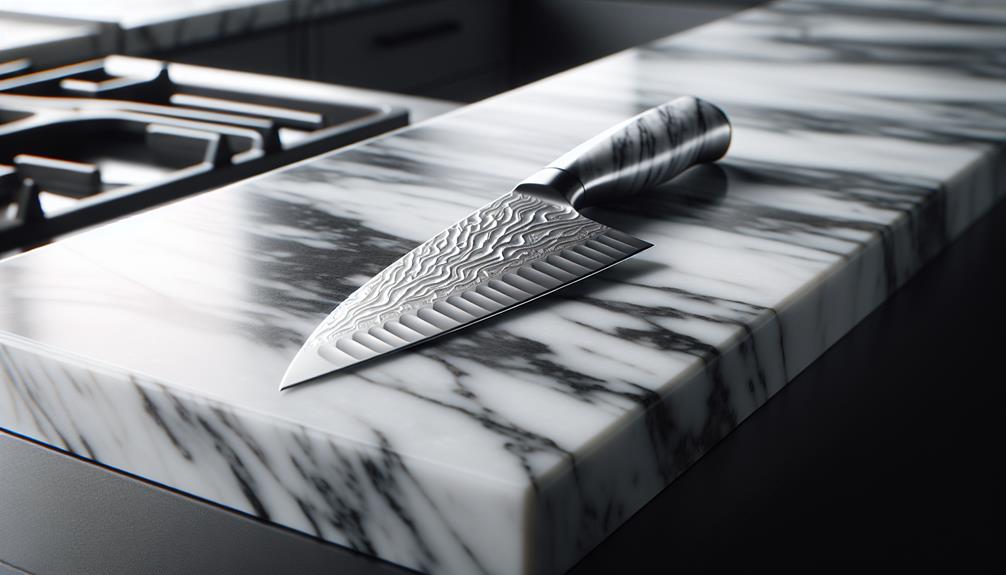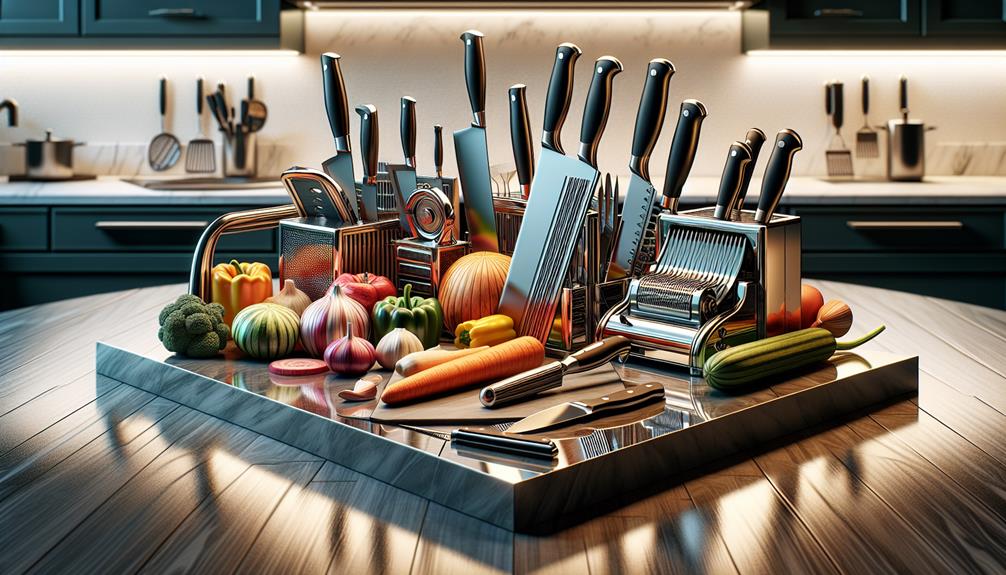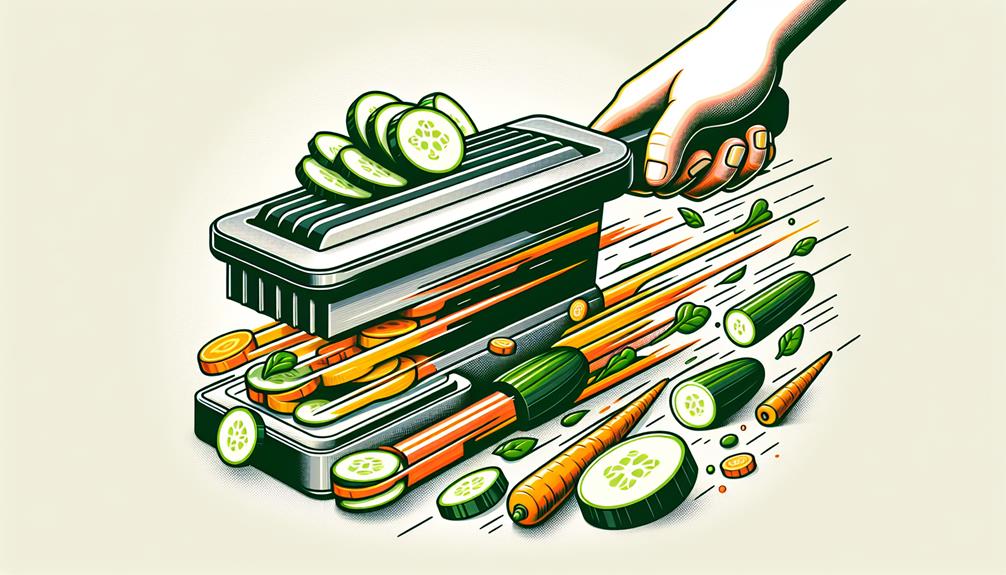You're about to discover the secret to effortless food prep and presentation. Imagine slicing through even the toughest ingredients with precision and ease, every cut a reflection of your skill. Master Cutting's high-end chef knives, crafted with traditional Japanese steel-making techniques and cutting-edge tech, promise unparalleled performance. But what sets them apart from other premium knives on the market? Is it the high-carbon steel blades, the advanced coatings, or something more? You're one step away from revealing the full potential of your culinary creations.
Precision Forged Japanese Steel
With every slice, the exceptional sharpness of precision forged Japanese steel chef knives rewards your skilled hand with effortless cuts and unparalleled results. You're not just holding a knife, you're wielding a piece of history. Japanese steel has a rich cultural significance, dating back to the 14th century when samurai swords were forged. The same techniques and attention to detail that created those legendary blades are now used to craft premium chef knives. The art of Japanese steel-making has been passed down through generations, with each new craftsman building upon the knowledge of their predecessors. This dedication to excellence has resulted in steel that's both incredibly strong and remarkably flexible. As you slice through ingredients with ease, you're experiencing the culmination of centuries of expertise and tradition. The precision forged Japanese steel chef knives in your hand are a symbol of the country's enduring passion for craftsmanship and its commitment to producing the very best.
High-Carbon Content Blades
You're holding a knife that's not just sharp, but also incredibly durable, thanks to its high-carbon content blade, which allows it to maintain its edge and resist corrosion. This is because high-carbon steel contains a minimum of 0.5% carbon, making it harder and more resistant to wear and tear. With a higher carbon content, the blade can hold its edge longer, requiring less maintenance and sharpening. This not only saves you time but also reduces your carbon footprint in the long run.
As you venture into the world of high-end chef knives, you'll discover that steel history plays a significant role in the development of these exceptional blades. The use of high-carbon steel dates back to ancient times, with Japanese swordsmiths perfecting the art of creating razor-sharp blades. Today, high-carbon content blades are sought after by professional chefs and home cooks alike for their unparalleled performance and durability. With proper care, a high-carbon blade can last a lifetime, making it a worthwhile investment for any serious cook.
Cryogenic Quenching Process
As you explore the cryogenic quenching process, you'll discover that controlling the cooling rate is essential to achieving the perfect blade. This process allows you to manipulate the microstructure of the steel, resulting in a stronger, more durable knife. By understanding how cryogenic quenching works, you'll appreciate the science behind crafting exceptional chef knives.
Cooling Rate Control
During the cryogenic quenching process, controlling the cooling rate becomes crucial to achieve the desired microstructure and hardness in your chef knife's blade. You need to manage the thermal energy transfer to prevent unwanted material transformations. This is where thermal management comes into play. By carefully regulating the cooling rate, you can influence the material properties of your blade. A slow and controlled cooling process allows for a more uniform heat transfer, reducing the risk of thermal shocks that can lead to crack formation or warping. This, in turn, enables you to achieve the perfect balance of hardness, toughness, and corrosion resistance in your blade. By mastering the cooling rate control, you can tap into the full potential of your cryogenic quenching process and produce high-performance chef knives that excel in the kitchen.
Microstructure Transformation
By plunging your chef knife's blade into the cryogenic quenching bath, the rapid cooling triggers a microstructure transformation that reconfigures the steel's crystal lattice, ultimately dictating the blade's final properties. This process is vital, as it enables the microstructure evolution that gives high-end knives their exceptional performance. As the blade cools, the steel's crystal lattice undergoes a profound change, allowing for grain refinement that enhances its strength, toughness, and corrosion resistance.
During this transformation, the blade's microstructure shifts from a coarse, disordered arrangement to a finer, more uniform one. This refinement process eliminates defects and imperfections, resulting in a more homogeneous steel that's less prone to cracking or breaking. The cryogenic quenching process accelerates this transformation, allowing for a more dramatic and consistent refinement of the steel's microstructure. The end result is a blade that's not only sharper but also more durable and resistant to wear, making it an indispensable tool for any serious chef. By harnessing the power of microstructure transformation, you can tap the full potential of your chef knife and take your culinary skills to the next level.
Expertly Sharpened Edges
As you explore the world of expertly sharpened edges, you'll discover the secrets to maintaining a razor-sharp blade. You'll learn how to refine your edge refinement techniques, ensuring your knife stays sharp for longer. By mastering these skills, you'll tap into the full potential of your chef knife, making even the most intricate cuts a breeze.
Sharpness Retention Secrets
You'll be pleased to know that expertly sharpened edges can retain their sharpness for a longer period, thanks to a few secrets that top chefs and knife enthusiasts swear by. Proper knife maintenance is key to extending the life of your blade's sharpness. This includes regular cleaning and drying to prevent rust, storing your knives in a dry place, and avoiding cross-contamination of ingredients. Additionally, the type of steel used in your knife plays a significant role in sharpness retention. High-carbon stainless steel, for example, is more resistant to corrosion and holds its edge longer than other materials. When selecting a knife, look for high-quality steel that's resistant to rust and corrosion. By combining these factors, you'll be able to enjoy a sharp, high-performance blade for a longer period. With the right maintenance and steel selection, you'll be chopping, slicing, and dicing like a pro in no time. By following these secrets, you'll get the most out of your investment and experience the joy of cooking with a truly exceptional knife.
Edge Refinement Techniques
Refine your edge with precision using expert techniques that separate the masters from the amateurs. A well-refined edge is vital for a high-performance chef knife, and it all starts with understanding edge geometry. The angle and shape of your edge can make or break its sharpness and durability. By mastering edge geometry, you'll be able to create a razor-sharp blade that slices through even the toughest ingredients with ease.
One technique to take your edge refinement to the next level is the use of micro bevels. These tiny, precision-ground bevels along the edge of the blade create a more aggressive cutting angle, allowing for effortless slicing and dicing. By incorporating micro bevels into your sharpening routine, you'll be able to achieve a level of sharpness that's unmatched by amateur sharpening techniques. With a refined edge and micro bevels, you'll be able to tackle even the most demanding kitchen tasks with confidence and precision. By combining these expert techniques, you'll be able to tap into the full potential of your high-end chef knife and take your cooking to new heights.
Ergonomic Handle Designs
Most high-end chef knives feature ergonomic handle designs that cradle your palm, reducing fatigue and improving control during extended cooking sessions. These designs are tailored to fit comfortably in your hand, allowing you to work efficiently without strain. One key aspect of ergonomic handles is the contoured grip, which provides a snug fit for your palm. This design element helps to prevent slipping and sliding, even when your hands are wet or greasy. Additionally, many high-end chef knives feature finger notches, strategically placed to guide your fingers into the ideal grip position. These notches help to distribute the weight of the knife evenly, reducing fatigue and improving precision. By combining contoured grips and finger notches, ergonomic handle designs enable you to maintain a secure grip, even during the most demanding cooking tasks. With an ergonomic handle, you'll be able to chop, slice, and dice with confidence, knowing that your knife is working in harmony with your hand.
Advanced Coating Technology
Advanced coating technology takes high-end chef knives to the next level, allowing them to slice through even the toughest ingredients with ease. When you're working with premium blades, you want to guarantee that they maintain their sharpness and performance over time. That's where advanced coating technology comes in. By applying specialized coating materials to the blade, manufacturers can enhance the knife's durability, resistance to corrosion, and non-stick properties.
You'll find that many high-end chef knives feature nano layers, which are incredibly thin coatings that provide exceptional protection and performance. These nano layers can be made from materials like titanium nitride, diamond-like carbon, or ceramic, each offering unique benefits. For instance, titanium nitride coatings provide exceptional hardness and wear resistance, while diamond-like carbon coatings offer superior non-stick properties. By combining these advanced coatings with precision-crafted blades, you get a knife that's not only razor-sharp but also incredibly durable and low-maintenance. With advanced coating technology, you can trust that your high-end chef knife will continue to deliver exceptional performance, even after heavy use.
High-Performance Cutting Action
As you move on to the high-performance cutting action of your chef knife, you'll notice that the razor-sharp blade edges make all the difference. You'll be able to slice through even the toughest ingredients with ease, and the effortlessness of the cut will become second nature. What's more, the knife's design guarantees that food releases effortlessly, making the entire chopping process a breeze.
Razor-Sharp Blade Edges
You'll get the best high-performance cutting action from a chef knife with a razor-sharp blade edge, which can slice through even the toughest ingredients with ease. This is because a sharp blade requires less pressure and effort to cut, making it more efficient and reducing fatigue. However, maintaining that sharp edge is essential. Regular Blade Maintenance is key to keeping your knife in top condition. You should hone your knife regularly to realign the blade's teeth and remove minor imperfections. This will help maintain the edge's sharpness and prevent it from becoming dull.
When handling a razor-sharp blade, Edge Safety is paramount. Always cut away from your body and keep your fingers curled under to avoid accidental cuts. It's also vital to store your knife properly when not in use, preferably in a knife block or on a magnetic strip, to prevent accidents and damage to the blade. By prioritizing Blade Maintenance and Edge Safety, you'll be able to enjoy the benefits of a razor-sharp blade edge and take your cooking to the next level.
Effortless Food Release
With each smooth, precise cut, your ingredients effortlessly release from the blade, thanks to the chef knife's high-performance cutting action. This seamless release is a result of the knife's advanced blade technology, which minimizes friction and maximizes cutting efficiency. Whether you're chopping delicate herbs or slicing through tender meat, the high-performance cutting action guarantees that your ingredients release cleanly, without tearing or crushing.
The texture of your food is preserved, allowing you to achieve the perfect consistency in your dishes. For instance, when chopping veggies for a stir-fry, you want them to retain their crunch, not turn into mush. With a high-end chef knife, you can achieve just that. Additionally, the effortless food release enables you to master various cooking techniques, such as julienning, dicing, or mincing, with ease and precision. This, in turn, opens up a world of possibilities for creative cooking and presentation. By choosing a high-performance chef knife, you'll experience the difference it makes in your cooking, and your dishes will thank you.
Hand-Sharpened Cutting Edges
Sharpening your chef knife by hand gives you complete control over the cutting edge's angle and curvature, allowing you to tailor it to your personal cutting style. This level of customization is vital for high-end chefs who demand precision and consistency in their work. When you sharpen by hand, you can adjust the edge to suit your specific needs, whether that's a razor-sharp point for intricate work or a more rounded edge for heavy-duty chopping.
To get the most out of hand-sharpening, mastering various sharpening techniques, such as the 'V' bevel and the 'scandi' grind, is imperative. These techniques will help you achieve a razor-sharp edge that slices through ingredients effortlessly. Additionally, regular edge maintenance is critical to prevent dulling and maintain the knife's performance. By incorporating hand-sharpening into your daily routine, you'll be able to detect even the slightest changes in the edge's performance, allowing you to make adjustments on the fly. With practice and patience, you'll develop the skills to craft a cutting edge that's truly exceptional.
Super High-Speed Steel
Super High-Speed Steel (SHSS) chef knives boast exceptional durability and resistance to corrosion, thanks to their unique composition of high-carbon content and advanced alloying elements. You'll appreciate the superior performance of these knives, which can maintain their sharpness even after prolonged use. SHSS chef knives owe their remarkable properties to the high-speed steel used in their construction. This steel type is renowned for its hardness, toughness, and resistance to wear and tear.
As you explore the world of high-end chef knives, you'll discover that SHSS is a popular choice among professional chefs and serious home cooks. Its exceptional steel properties make it an ideal material for demanding industrial applications, such as cutting through tough ingredients or withstanding the rigors of high-volume food preparation. When you hold an SHSS chef knife in your hand, you'll appreciate the weight, balance, and precision engineering that go into creating these exceptional cutting tools. With proper care and maintenance, your SHSS chef knife will remain a trusted companion in the kitchen for years to come.
Nitrogen-Infused Blade Cores
You'll take your knife game to the next level with nitrogen-infused blade cores, which inject a burst of strength and agility into your cutting experience. This innovative technology allows for a stronger, more durable blade that's less prone to corrosion and wear. The nitrogen infusion process creates a harder, more resilient core that can withstand the rigors of daily use, making it an essential feature for professional chefs and serious home cooks.
In the world of blade mythology, a great knife is only as good as its core. That's why nitrogen-infused blade cores are a game-changer. By rethinking traditional core innovation, manufacturers have created a new standard for high-performance knives. The result is a blade that's not only stronger but also more agile, with a razor-sharp edge that stays sharp longer. Whether you're chopping, slicing, or dicing, a nitrogen-infused blade core gives you the confidence to take on any culinary challenge. With its unparalleled strength and agility, this cutting-edge technology is sure to elevate your cooking experience to new heights.
Frequently Asked Questions
Can I Put My High-End Chef Knives in the Dishwasher?
You're wondering if you can toss your prized knives in the dishwasher, but beware – the Dishwasher Dilemma can lead to a Cleaning Conundrum, causing damage and dullness. Hand washing is still the safest bet for your high-end blades.
How Often Should I Sharpen My Master Cutting Knives?
You should sharpen your knives regularly to maintain cutting efficiency. Aim to sharpen them every 1-3 months, depending on usage, to prevent dulling and facilitate precise cuts, saving you time and effort in the kitchen.
Are High-End Chef Knives Suitable for Left-Handed Users?
You're wondering if high-end chef knives are suitable for left-handed users. Thankfully, many premium knives feature ambidextrous designs and ergonomic handles, ensuring a comfortable grip and effortless maneuverability for both right- and left-handed chefs.
Can I Use My Master Cutting Knives to Cut Through Bone?
You shouldn't use your knives to cut through bone, as it can dull the blade; instead, adopt specialized bone cutting techniques and meat preparation methods, like sawing or chopping, to facilitate a precise and safe cut.
Are High-End Chef Knives Worth the Investment for Home Cooks?
You're wondering if splurging on high-end chef knives is worth it for home cooking. Honestly, investing in quality knives boosts your cooking confidence and elevates your kitchen status, making every meal prep a joy.
Conclusion
You've experienced the pinnacle of culinary excellence with Master Cutting's premium chef knives. By combining traditional Japanese steel-making techniques with cutting-edge technology, these exceptional blades deliver unparalleled performance. With their durable, corrosion-resistant high-carbon steel, expertly sharpened edges, and ergonomic handles, you'll slice through even the toughest ingredients with ease. Elevate your cooking game with Master Cutting's high-end chef knives, precision-engineered to make a lasting impression in the culinary world. In addition to our premium chef knives, Master Cutting also offers a range of dual functionality kitchen appliances that are designed to streamline your cooking experience. Our innovative designs and unparalleled quality make our products a must-have for any culinary enthusiast. From slicing and dicing to mixing and blending, Master Cutting’s kitchen appliances are the perfect addition to any professional or home kitchen.





